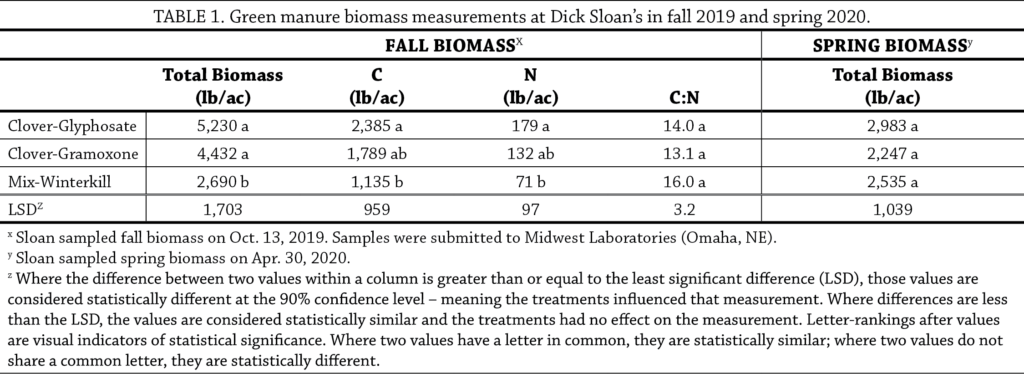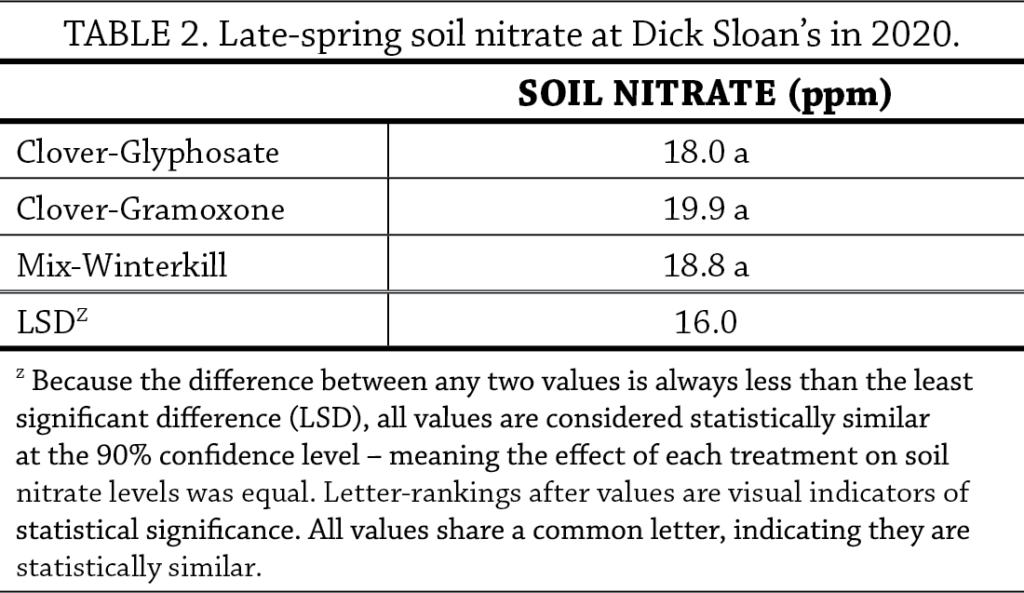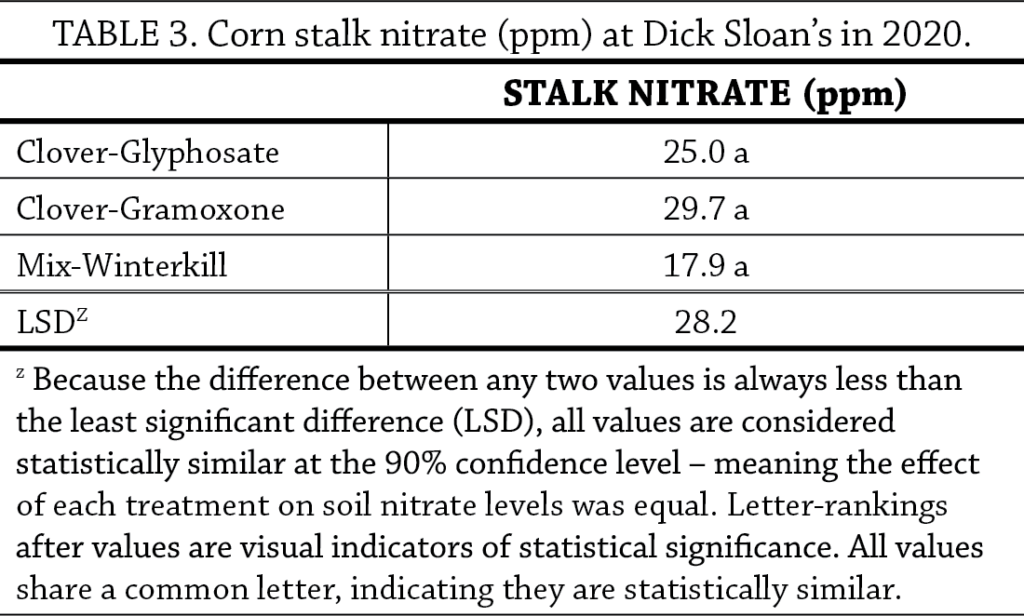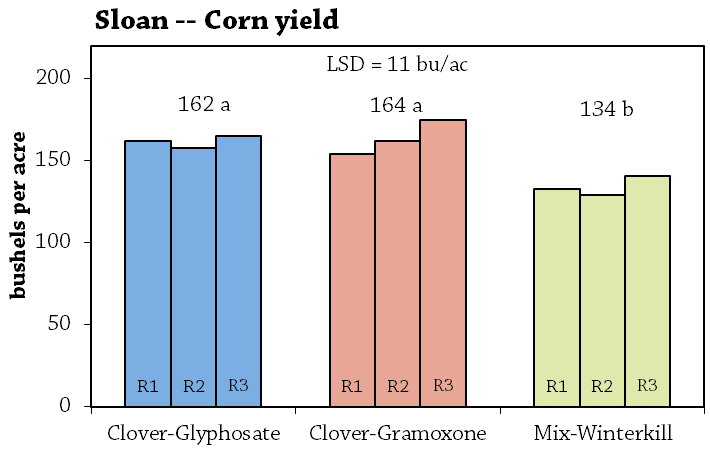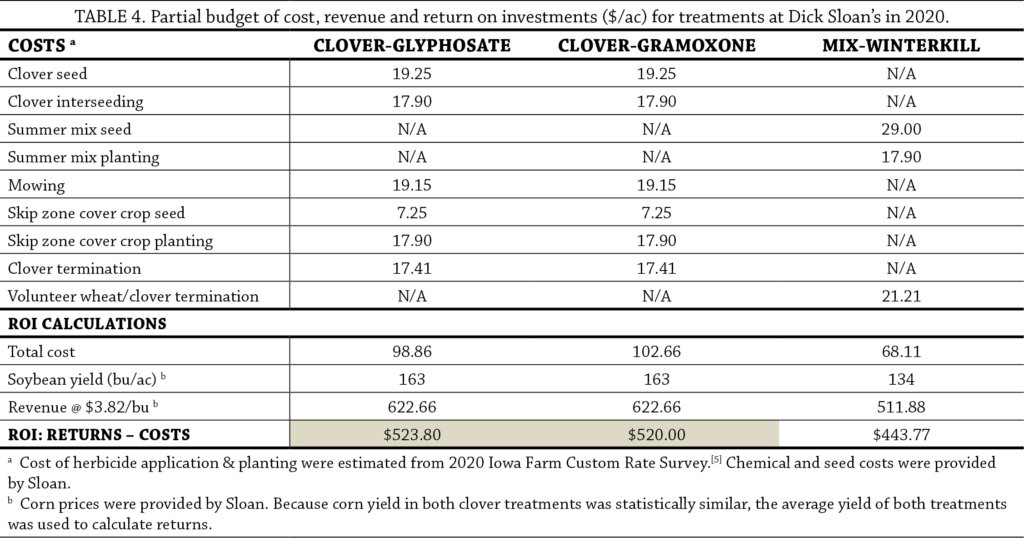Green Manure Cover Crop Seeding and Termination Dates in Wheat-Corn Rotation
This research was funded by the Walton Family Foundation.
In a Nutshell:
- The objective of this trial was to determine the most profitable and sustainable green manure system for planting between winter wheat and corn.
- Sloan compared cover crop biomass and corn yield among three treatments: two in which a clover blend was interseeded to wheat and terminated the following spring but with different herbicides, and a third in which a winterkill cover crop mix was drilled following wheat harvest.
Key Findings:
- Interseeding red and alsike clover to wheat then terminating it the subsequent spring –regardless of termination herbicide used – generated greater corn yields and a better return on investment by $80/ac compared to a winterkill cover crop mix drilled following wheat harvest.
Background
Since 2013, PFI member Dick Sloan has played with an expanded three-year rotation of winter small grains between soybean and corn. Among the small grains he grows are winter wheat and cereal rye, which he harvests and then plants as cover crops. The summer harvest of winter small grains provides a window of opportunity to grow soil nitrogen ahead of corn by means of establishing a green manure. Sloan has experimented with different interseeded clover mixes as well as summer-seeded winterkill mixes. Previous on-farm research conducted by himself and Wade Dooley showed that cereal rye followed by clover mixes led to greater corn yields and return on investments compared to following cereal rye with cloverless mixes.[1,2] However, while Sloan asserts “it’s hard to beat a medium red and alsike clover blend interseeded to established winter small grains,” he notes that “no-tilling corn into clover that has just been terminated doesn’t work well.”
In an effort to fine-tune his clover management program, Sloan wanted to see if terminating clover in the fall rather than spring might facilitate easier corn planting. Additionally, Sloan wondered if reserving clover skip zones into which a winterkill green manure and then corn could be planted would also help.
The objective of this trial was to determine the most profitable and sustainable green manure system to follow Sloan’s winter wheat crop. Sloan’s original intent was to compare fall-terminated red/alsike clover and spring-terminated red/alsike clover with a summer-seeded winterkill green manure mix; however, short on time to terminate clover in the fall, he terminated both clover treatments in the spring and compared the following treatments instead:
- Clover-Glyphosate –red/alsike clover interseeded with skip zones to winter wheat and terminated the subsequent spring with Glyphosate; winterkill cover crop planted in skip zones following wheat harvest
- Clover-Gramoxone – red/alsike clover interseeded with skip zones to winter wheat and terminated the subsequent spring with Gramoxone; winterkill cover crop planted in skip zones following wheat harvest
- Mix-Winterkill – winterkill cover crop mix seeded after winter wheat harvest
Methods
Design
Sloan initiated the trial by drilling winter wheat into soybean stubble on Oct. 21, 2018. He drilled the wheat in 7.5-in. rows at a rate of 120 lb/ac. The following spring, Sloan applied 45 lb N/ac, 20 lb P/ac and 30 lb K/ac to the trial plot.
Sloan established treatment strips on April 9, 2019, by interseeding a 60/40 blend of red and alsike clover into 30-ft-wide strips of winter wheat that were pre-assigned the clover-glyphosate or clover-Gramoxone treatment (Figure A1). Sloan drilled the clover blend in those treatments in 7.5-in. rows at a rate of 7.2 lb/ac in 7.5 in. rows, leaving skip zones on 30-in. centers for a winterkill cover crop and then corn. Strips assigned the mix-winterkill treatment remained untouched at this point and consisted only of winter wheat.
On July 22, 2019, Sloan harvested wheat from all treatments. He then mowed the clover in both clover treatments.
On July 31, 2019, Sloan sprayed Tomahawk (1 qt/ac) in the mix-winterkill treatment strips for weed control. In the same strips, he planted the green manure three days later (Aug. 3). The mix was drilled in 7.5-in. rows at a rate of 28 lb/ac and consisted of forage pea (8.4 lb/ac), soybean (2.5 lb/ac), spring triticale (3.3 lb/ac), buckwheat (3.3 lb/ac), badger radish (1.7 lb/ac), crimson clover (4.2 lb/ac), berseem clover (4.2 lb/ac) and brown mustard (0.4 lb/ac).
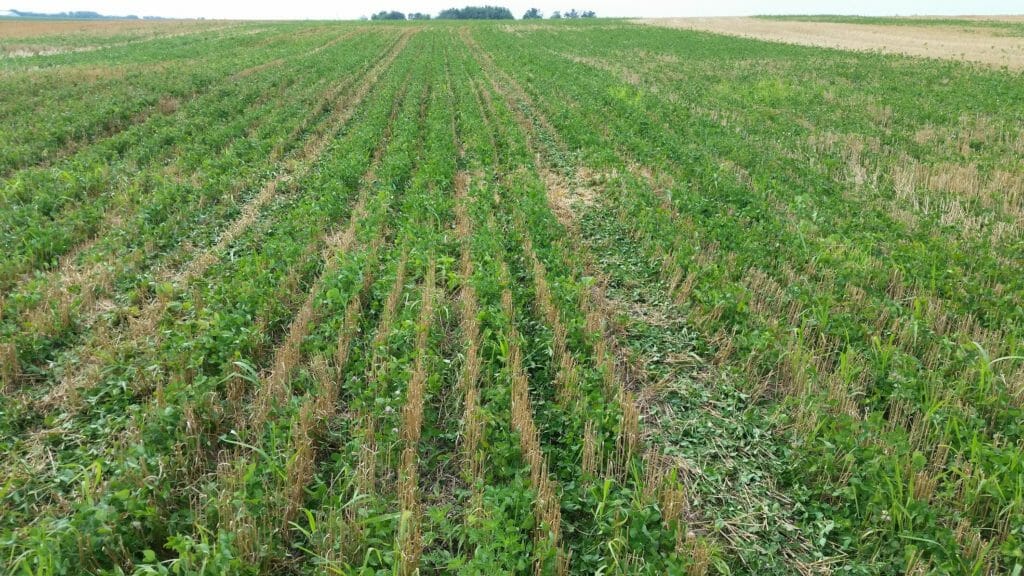
Wheat stalks (brown) remain standing two weeks after harvest, and red and alsike
clover appears green at four months after interseeding it to winter wheat. Photo
taken Aug. 5, 2019.
Sloan drilled a cover crop in the 30-in. skip zones of the clover treatment strips on Aug. 5, 2019. The cover crop was drilled at a rate of 7 lb/ac and consisted of forage pea (2.1 lb/ac), soybean (0.6 lb/ac), spring triticale (0.8 lb/ac), buckwheat (0.8 lb/ac), badger radish (0.4 lb/ac), crimson clover (1 lb/ac), berseem clover (1 lb/ac) and brown mustard (0.1 lb/ac).
On April 7, 2020, Sloan fertilized all strips with 11 lb N/ac, 52 lb P/ac and 90 lb K/ac. Nearly 1 month later, on May 2, he terminated the red and alsike clover green manures. For the clover-glyphosate treatment, Sloan used a tank mix of Roundup Powermax (2 pt/ac), atrazine (1 lb/ac) and Sterling Blue (1 pt/ac). For the clover-Gramoxone treatment, Sloan applied a tank mix of Gramoxone (3 pt/ac), atrazine 90DF (1 lb/ac) and Sterling Blue (1 pt/ac). After observing volunteer winter wheat and some clover in the mix-winterkill treatment strips, Sloan sprayed the mix-winterkill strips on May 2 using the same tank mix as the clover-Gramoxone treatment.
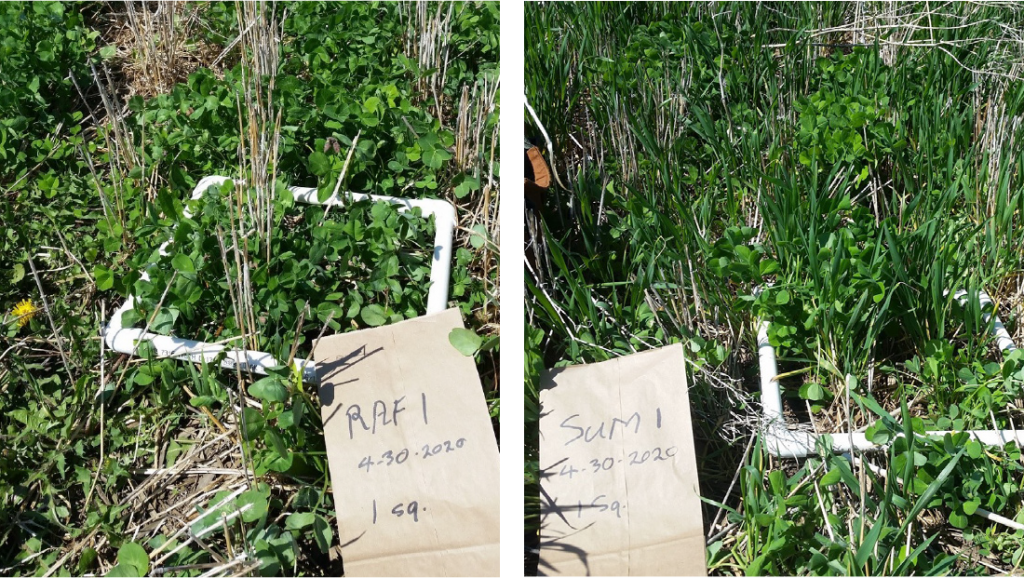
In spring 2020, biomass in the clover-glyphosate treatment (left) consisted of overwintered red and alsike clover; and biomass in the mix-winterkill treatment consisted of volunteer winter wheat and clover. Photos taken April 30, 2020.
Sloan applied starter fertilizer and planted corn in all treatments on May 9 – one week after terminating the green manures and volunteer winter wheat. Corn was planted in 30-in. rows at a population of 35,000 seeds/ac. The starter fertilizer provided 32 lb N/ac, 18 lb P/ac, 5 lb K/ac and 15 lb S/ac from a tank mix of Optistart5, UAN(32) and thiosulfate (18 gal/ac).
On May 31, Sloan applied a tank mix of Powermax (22 oz/ac) and Resicore (3 pt/ac) to all treatment strips for weed control. Sloan again fertilized all treatment strips on June 26 with a tank mix of UAN(32) urea and Nutrisphere, which provided 63 lb N/ac.
Sloan arranged treatments randomly in neighboring strips and replicated each treatment three times for a total of nine strips (Figure A1). This treatment arrangement allowed us to conduct statistical analyses to assess the effects of each green manure system on cover crop biomass, soil and stalk nitrate and corn yield. Treatment strips measured 30 ft wide by 790 ft long.
Measurements
Sloan collected aboveground cover crop biomass samples in all treatment strips on Oct. 13, 2019, and on April 30, 2020. He submitted fall 2019 biomass samples to Midwest Laboratories (Omaha, NE) to test for carbon and nitrogen and to determine the total weight of dry biomass. For the spring 2020 samples, he recorded only the weight of the biomass after air drying.
Sloan sampled for late-spring soil nitrate testing on June 8, 2020 – one month after planting corn. He collected several soil cores to a 6-in. depth in each strip and submitted samples to Ag Source Laboratories (Ellsworth, IA) to determine differences in soil nitrate availability to corn. On Oct. 4, Sloan sampled corn stalks for stalk nitrate testing.
Sloan harvested corn in all strips on Oct. 16, 2020. Yields were adjusted to standard moisture (15.5%).
Data analysis
To compare the effects of each green manure system on cover crop biomass, nitrogen availability and corn yield, we calculated the averages for each treatment then used Tukey’s tests to compute least significant differences (LSDs) at the 90% confidence level. The difference between two averages is compared with the corresponding LSD to determine if one treatment’s effect is significantly different from the other’s effect. Differences greater than or equal to the LSD indicate the presence of a statistically significant treatment effect, meaning one treatment outperformed the other and Sloan can expect the same effects to occur 90 out of 100 times under the same conditions. A difference that is less than the LSD indicates the difference is not statistically significant and the treatment had no effect.
Results and Discussion
Green manure biomass – Fall 2019, spring 2020
In fall 2019, the clover treatments produced more total biomass than the mix-winterkill treatment; however, only the clover-glyphosate treatment generated more carbon and more nitrogen than the mix-winterkill treatment (Table 1). The amount of carbon and nitrogen generated in the clover-Gramoxone treatment was statistically similar to the amount generated by the other two treatments.
At the time of sampling fall biomass, the red and alsike clovers in the clover-Gramoxone and clover-glyphosate treatments had been growing for six months while the summer mix in the mix-winterkill treatment had only grown for two months. For this reason, it is unsurprising that total biomass was greatest for both clover treatments.
Although green manure biomass in spring 2020 was statistically similar across treatments (Table 1), these results are a bit misleading. Sloan expected the green manure in the mix-winterkill treatment to winterkill and therefore hypothesized it would generate less total spring biomass than the clover treatments. At the time of sampling, Sloan observed that biomass in the clover treatments consisted only of clover while biomass in the mix-winterkill treatment consisted mostly of volunteer winter wheat with some clover.
Late-spring soil nitrate
Soil nitrate levels were statistically similar across treatments; however, great variation among samples within a given treatment makes it difficult to rely on these data (Table 2).
Stalk nitrate
Corn stalk nitrate levels were statistically similar between treatments (Table 3). Stalk nitrate levels were below 250 ppm for all treatments, which indicates corn might have benefitted from additional nitrogen.[3] Nitrogen uptake might have been limited, however, due to periods of extremely low rainfall in July and August (Figure A2).
Corn yield
Corn in both clover treatments yielded significantly greater than corn in the mix-winterkill treatment (Figure 1). The clover treatments out-yielded the winterkill mix by roughly 30 bu/ac. Yields in all three treatments were lower than the Buchanan county average for 2020 (189 bu/ac) by more than 25 bu/ac.[4] It is worth mentioning that Sloan achieved the corn yields in this experiment with only 106 lb N/ac applied.
Economic considerations
The return on investments (ROI) was greatest in the clover-glyphosate treatment ($523.80/ac); however, it differed from the clover-Gramoxone treatment ($520.00/ac) only by $3.80/ac (Table 4). The ROI in the mix-winterkill treatment was $443.77/ac – $80/ac less than the clover treatments.
Conclusions and Next Steps
Compared to planting a diverse cover crop mix after wheat harvest and allowing it to winterkill, interseeding red and alsike clover to wheat then terminating it the subsequent spring provided Sloan with better corn yields and a better return on investment by $80/ac. Sloan commented, “I like planting a diverse mix of cover crops in the summer following small grain harvest, but it just doesn’t give the same boost to the following year’s corn yields as the clover blend does.” Although Sloan was hindered from terminating one of his clover treatments in the fall as originally planned, he was satisfied this trial backed up his observations from previous on-farm research in which interseeding red and alsike clovers to winter small grains provided good weed control.
Appendix – Trial Design and Weather Conditions
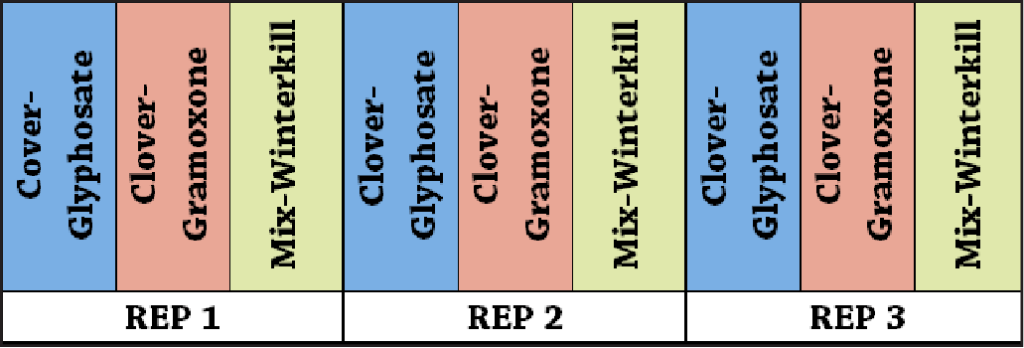
FIGURE A1. Dick Sloan’s experimental design consists of three replications of each treatment. This design allows for statistical analysis of the data.

FIGURE A2. Mean monthly temperature and rainfall and the long-term averages during the trial period at Independence, the nearest weather station to Sloan’s farm (about 7 miles away).[6]
References
- Gailans, S. and W. Dooley. 2016. Effect on corn of green manure cover crops established with cereal rye seed crop. Practical Farmers of Iowa Cooperators’ Program. https://practicalfarmers.org/research/effect-on-corn-of-green-manure-cover-crops-established-with-cereal-rye-seed-crop/ (accessed May 2021).
- Gailans, S. and D. Sloan. 2015. Corn Following Green Manure Cover Crops Established with Small Grain. Practical Farmers of Iowa Cooperators’ Program. https://practicalfarmers.org/research/corn-following-green-manure-cover-crops-established-with-small-grain/ (accessed May 2021).
- Sawyer, J.E. and A.P. Mallarino. 2018. Use of the End-of-Season Corn Stalk Nitrate Test in Iowa Corn Production. CROP 3154. Iowa State University Extension and Outreach. https://store.extension.iastate.edu/Product/5089 (accessed February 2021).
- Johanns, A. 2021. Historical Corn Yields by County in Iowa. Ag Decision Maker. Iowa State University Extension and Outreach. https://www.extension.iastate.edu/agdm/crops/html/a1-12.html (accessed April 2021).
- Plastina, A., A. Johanns and O. Massman. 2020. 2020 Iowa Farm Custom Rate Survey. FM1 1698. Ag Decision Maker. Iowa State University Extension and Outreach. https://www.extension.iastate.edu/agdm/crops/html/a3-10.html (accessed March 2021).
- Iowa Environmental Mesonet. 2021. IEM “Climodat” Reports. Iowa State University Department of Agronomy. https://mesonet.agron.iastate.edu/climodat/ (accessed March 2021).


